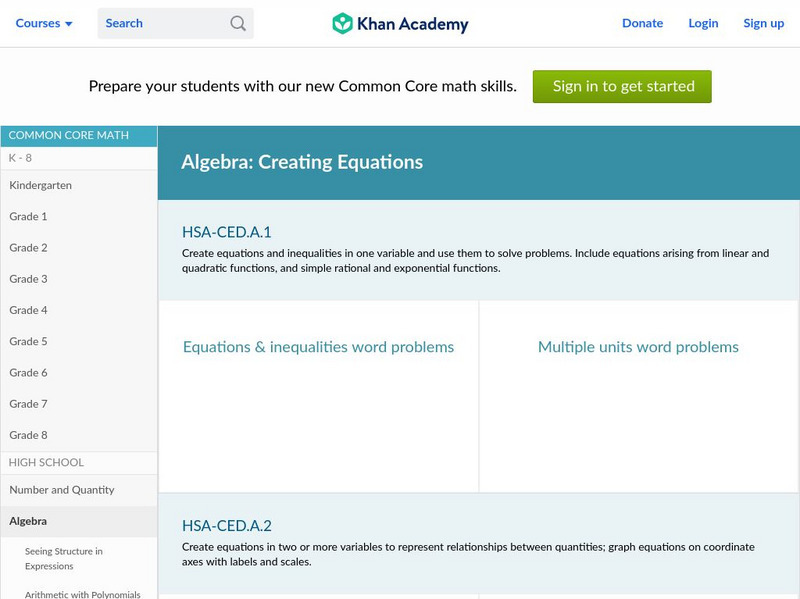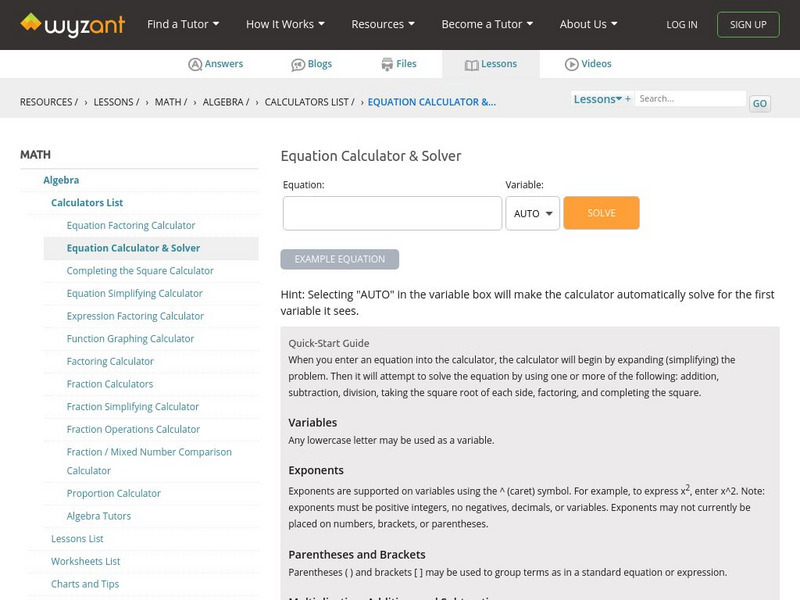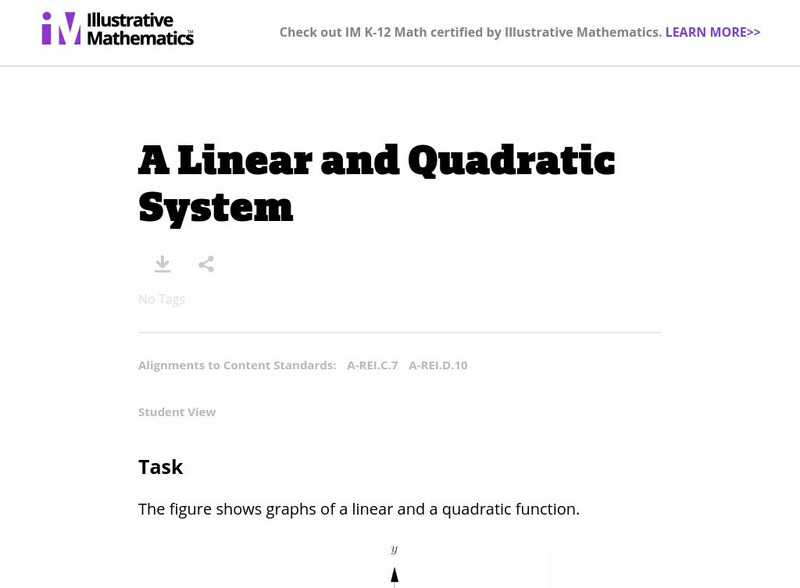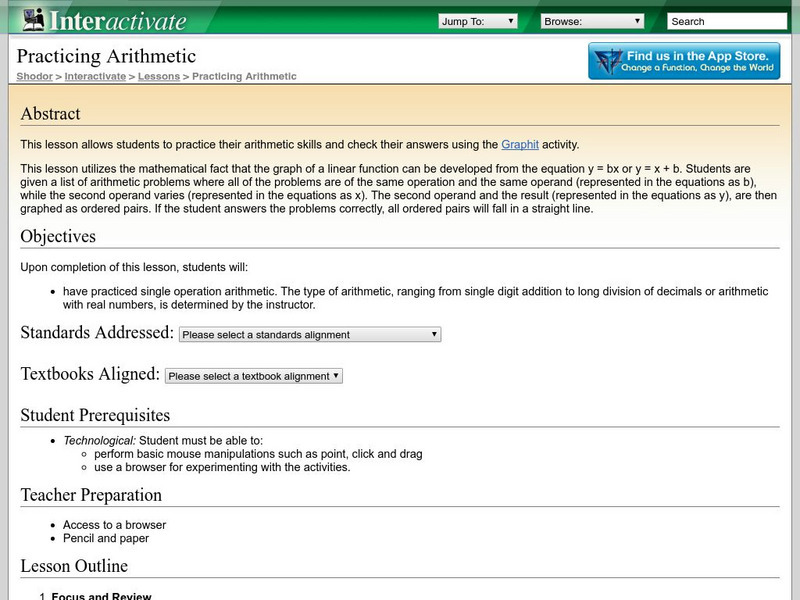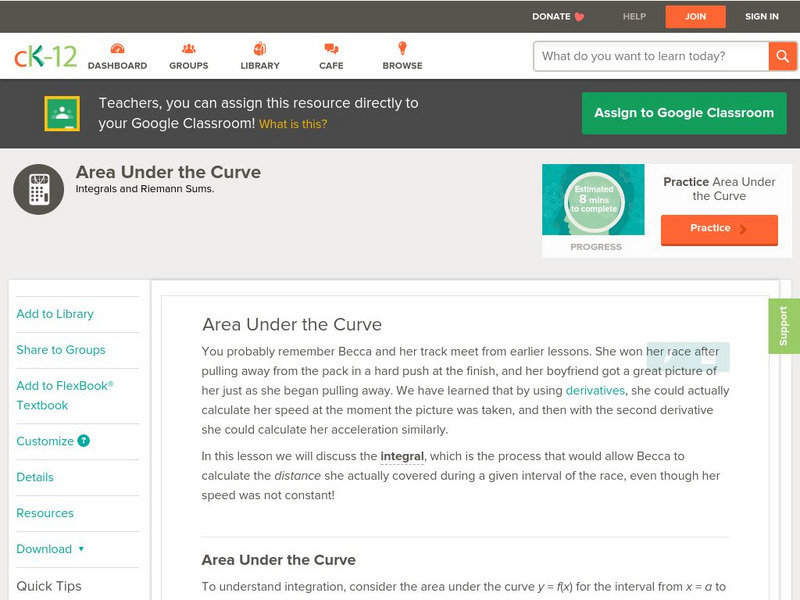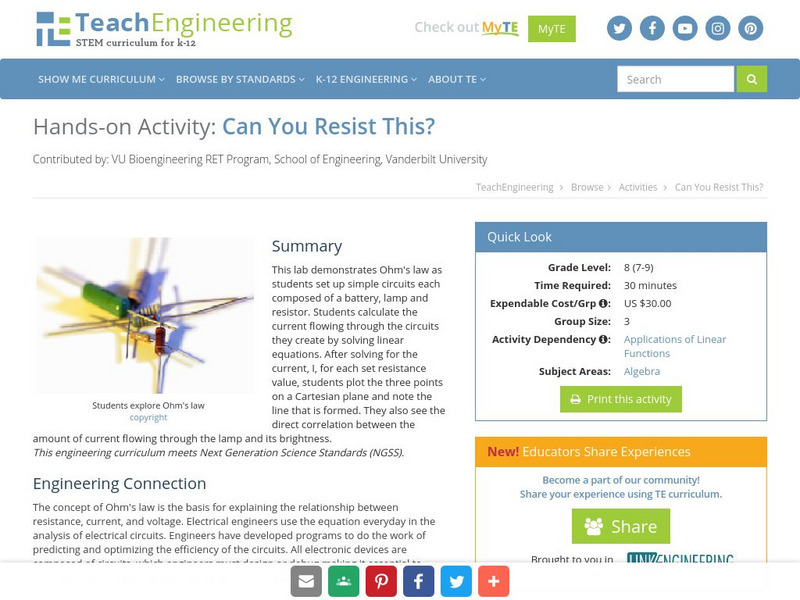Curated OER
Ohm's Law
Students explain the meaning of Ohm's Law, and plot a graph of voltage versus current, by explaining how the slope is the resistance of the circuit.
Curated OER
Can Stack
Young scholars are able to find the rule for summing consecutive numbers;
identify the pattern of triangular numbers. They then solve the given problem using logic and mathematical reasoning.
Curated OER
Rows of Numbers
Students generate patterns from a structured situation, find a rule for the general term, and express it in words and symbols. They also devise and use problem solving strategies in a systematic way.
Curated OER
Poppy Meets Pythagoras
Eighth graders find connections between numbers in a table; use Pythagoras' theorem in a general algebraic form; and measure accurately from a scale drawing to find a method that might enable the helicopter to land inside a rectangular...
Texas A&M University
Wtamu Virtual Math Lab: Intermediate Algebra: Graphing Linear Equations
A simple tutorial that will show you how to graph linear equations and functions after finding the x- and y-intercepts. Provides definitions, steps for sketching a graph, and several examples of linear equations and their graphs....
Discovery Education
Discovery Education: Web Math: Solve a Linear Equation Involving One Unknown
This WebMath site explains how to enter your equation with one variable and solve for that variable. It explains step-by-step how to solve the equations and gives the final solutions.
Other
Introduction to Simple Linear Regression
This introduction to simple linear regression includes graphs and a discussion of extrapolation and interpolation.
Math Medics
S.o.s. Math: Solving Equations
This tutorial explains how to solve a variety of equations, from simple to complex, and gives examples and solutions. Students are asked to solve for x before looking at a solution.
Khan Academy
Khan Academy: Equations & Inequalities Word Problems
HSA-CED.A.1: Interactive resource which create equations and inequalities in one variable and use them to solve problems. Include equations arising from linear and quadratic functions, and simple rational and exponential functions....
Hooda Math
Hooda Math: Balance Scales
Solve simple linear equations using a balance beam. Replicate the given equation by moving the blocks of X and 1 to the sides of the balance scale. Then use addition, subtraction, multiplication, and division to each side to solve for x.
Math Medics
S.o.s. Math: Algebra
This lesson provides basic instruction on the major concepts in algebra. Content includes a focus on fractions, units of conversion, complex numbers, quadratic equations, factorization and roots of polynomials, solving equations, systems...
Wyzant
Wyzant: Equation Calculator
Students can input an equation and have the site solve it for them, complete with steps shown and explanations given along the way. Equations must be simple, first- or second-degree with only one variable. A quick list of rules to follow...
Khan Academy
Khan: Lsn 8: Interpreting Relationships in Scatterplots/graphs/tables/equations
This lesson focuses on Interpreting and analyzing linear, quadratic, and exponential models and graphs. Students will use best fit lines to interpret contexts, distinguish whether contexts are linear or exponential functions, use the...
Texas Instruments
Texas Instruments: Nonlinear Pendulum Problems
In this activity, students explore the nonlinear model for a simple pendulum. They use the calculator to solve higher order differential equations.
CK-12 Foundation
Ck 12: Algebra: Radical Equations With Variables on Both Sides
[Free Registration/Login may be required to access all resource tools.] This lesson covers solving radical equations with variables on both sides of the equation.
Illustrative Mathematics
Illustrative Mathematics: A Rei Pairs of Whole Numbers
The premise of this problem is simple - students must find three whole numbers with three different sums when they are added in pairs. To do this, they set up a system of linear equations in three variables. Aligns with A-REI.C.6.
Texas Instruments
Texas Instruments: What's My Line?
This activity focuses on strengthening student understanding of connections among graphical, tabular, and algebraic representations of simple linear functions. They enter a simple program that allows them to determine the equations for...
Illustrative Mathematics
Illustrative Mathematics: A rei.c.7 & a rei.d.10: A Linear and Quadratic System
The purpose of this task is to give students the opportunity to make connections between equations and the geometry of the graphs. Aligns with A-REI.C.7and A-REI.D.10.
Shodor Education Foundation
Shodor Interactivate: Lesson: Arithmetic Practice W/ Ordered Pairs
The Shodor Education Foundation provides this lesson plan to have students practice simple computation that results in them graphing their answers. If they are accurate they will have a straight line. Students use an interactive...
Louisiana Department of Education
Louisiana Doe: Louisiana Believes: Eureka Math Parent Guide: Expressions and Equations
A guide to support parents as they work with their students with expressions and equations.
Texas Instruments
Texas Instruments: Velocity Test: Interpreting Velocity Graphs
In this activity, students' will use a motion detector to record the distance versus time data for the simple motion of a walker. They will calculate velocity from this graph and compare it with the velocity graph generated by the...
CK-12 Foundation
Ck 12: Analysis: Average Rate of Change
[Free Registration/Login may be required to access all resource tools.] Defining average rate of change and evaluating simple examples
TeachEngineering
Teach Engineering: Can You Resist This?
This lab demonstrates Ohm's law as students set up simple circuits each composed of a battery, lamp and resistor. Students calculate the current flowing through the circuits they create by solving linear equations. After solving for the...
Wolfram Research
Wolfram Science World: Cl Circuit
Shows how simple harmonic motion is used in a circuit comprised of an inductor and a capacitor. Includes detailed formula derivation utilizing calculus.








